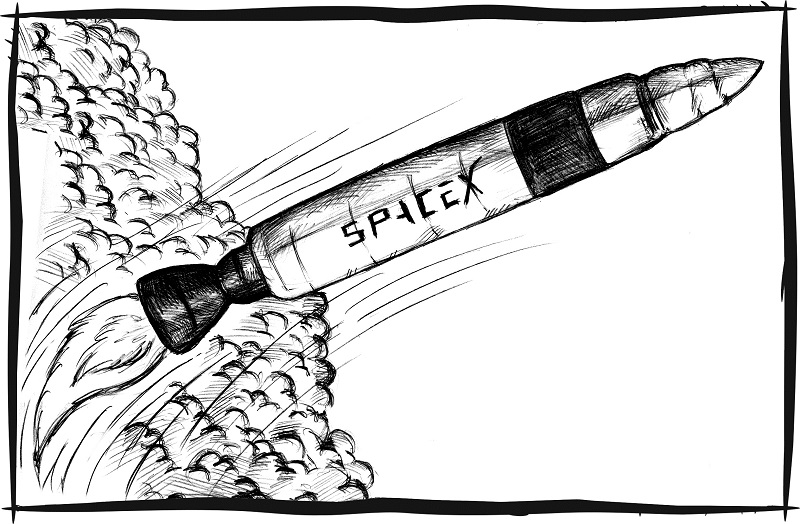
Spacecraft of the Week is a feature showing the engineering and design that went into creating the vehicles that explore our universe. Illustration by Larry Corby.
The predecessor to today’s Falcon 9, the Falcon 1 was SpaceX’s first foray into rocketry. As such, it became the first privately-developed vehicle in history to achieve orbit around the Earth.
The Falcon 1 had one Merlin engine compared to the nine boosting its predecessor, and its engines, electronics, and guidance systems are otherwise similar.
The Falcon 1’s closest competition in its time was the X-Prize winner SpaceShipOne, made with funding from Microsoft cofounder Paul Allen. But SpaceX founder Elon Musk wanted to be able to fly resupply missions to the International Space Station on the regular, and to send astronauts with them.
The Falcon 1 flew five times between 2006 and 2009, including SpaceX’s first commercial launch. It was a launch vehicle powered by two-stage liquid oxygen and rocket-grade kerosene, which combined a re-usable turbo-pump-fed first stage Merlin engine with a pressure-fed second stage Kestrel engine. In-house, Space-X developed rocket-grade kerosene that blasted out at 1,200 psi.
The Falcon 1’s classic rocket silhouette was 70 feet high and weighed 61,000 pounds mass at launch. Its first stage was made of friction-stir-welded aluminum alloy, with the second stage made of a cryogenic-compatible aluminum alloy.
As with some of SpaceX’s recent efforts, the first launches of the Falcon 1 weren’t entirely smooth. The first flight test, which took place in March of 2006, experienced an engine fire thanks to a fuel leak in the first stage engine. After this, fire protection blankets and nitrogen purges were installed in the engine compartments. Aluminum fittings were eliminated in regions exposed to ambient environments, as the leak was found to probably result from cracking in an aluminum alloy B-nut. Many autonomous sensor checks were also added to the existing ones used during the pre-launch countdown.
The second demonstration flight, an effort sponsored by DARPA and the United States Air Force, went more smoothly than the first. However, the rocket never reached orbital velocity, due to an oscillation in the second stage control system, probably caused by propellant sloshing around during the launch. This demonstration served to verify many of the rocket’s systems, however.
The speed of the development between the two iterations was impressive, with the rocket launching twice in one year.
The third flight carried several satellites, including one for the Air Force, but did not reach orbit because the stages failed to separate. It was the fourth flight that succeeded, allowing SpaceX to place a mock satellite, nicknamed Ratsat and emblazoned with an image of a rat, into orbit. The fifth was the Falcon 1’s first successful commercial effort, as it placed a Malaysian RazakSAT satellite into orbit.
A plan to make a second generation of the Falcon 1, called the Falcon 1e, was put in place during development. This would have replaced the second stage’s aluminum alloy with a new aluminum-lithium alloy and upgraded the thrust and payload capacity, but the upgrade was never completed. Instead, the Falcon 9 took over as SpaceX’s workhorse.
In the early 2000s, SpaceX had also planned to build a five-engine Falcon 5 rocket to follow the Falcon 1. Customers were clamoring for low cost enhanced launch capability, so the company upgraded the engine configuration straight to the Falcon 9. Plans to build the Falcon 5, which was almost identical to the Falcon 9 in all except engine number and configuration, were later discarded.
With each step of testing, Musk showed SpaceX’s determination to push the envelope of how humans can get to space. The Falcon 9 is scheduled for a commercial satellite mission in 2017, despite the difficulties faced in trying to re-use the rocket by landing it on a drone ship. I don’t doubt there will be big things ahead for the next generation of Falcons.
(By the way, you can experience the frustrations of landing a rocket on a drone ship in this neat game.)
Filed Under: Aerospace + defense




